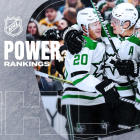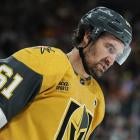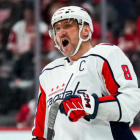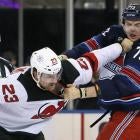More NHL: Scores | Standings | Odds | Fight-O-Meter | League Leaders | Rumors
During the first intermission of Thursday's Penguins-Flyers game, Root Sports Pittsburgh analyst (and former Penguins player) Jay Caufield was discussing what the Penguins needed to do to turn the tide in a game that saw them trailing by three goals after 20 minutes of play.
The analysis was fairly simple: They needed to be more physical, hit people, bang bodies, and set the tone. Get in there and play tough. Honestly, what follows here isn't meant to call out this particular broadcast. Really, it isn't. If you replaced the team names and network with any other game in the NHL on a given night, the analysis probably changes very little.
That doesn't make it right, but it's a league-wide problem.
Just go out there and hit somebody, will ya?
At that point in the game the NHL's gamesheet had the hits fairly even with the Flyers holding a slight 11-10 edge. Nevermind the fact that Pittsburgh's aggressiveness in the first period and apparent desire to play tough and show the Flyers who was boss, giving them the business, helped get them into penalty trouble (a common theme when these two teams get together), putting their struggling penalty kill unit on the ice to give up two more power play goals.
No, forget all of that. The Penguins at that point supposedly needed to be more physical.
(Just for an example as to what I'm talking about here: The Flyers' first goal, a power play tally from Jakub Voracek, was set up when Penguins forward James Neal went out of his way to hit Flyers captain Claude Giroux high, well after he dished the puck off to a teammate, and was sent off for elbowing. This, of course, is the wrong sort of physical play at the wrong time. It was pointless and had multiple negative consequences for the Penguins. Their third best player was in the penalty box, and it led to a goal against.)
Over the final 40 minutes of play, the Penguins were outhit 29-12 by the Flyers, putting them at a 40-22 disadvantage for the game. If you showed that stat to enough people, both analysts and fans, I'm sure a decent number of them would look at that as a team that was playing soft, getting physically beaten by a tougher group of players, and a team that was ultimately worn down and probably came out in the loss column.
Except that's not at all what happened.
The Penguins dominated the final 40 minutes, controlled the flow and pace of the game, never gave up the puck, and outscored the Flyers 4-0 on their way to a come-from-behind 5-4 win. They were outhit by such a drastic margin because they had the puck more than Philadelphia. A lot more.
And this is a perfect example as to why the hits statistic pretty much sucks.
Don't misunderstand the point here.
It's not that hitting your opponent and physical play is bad. Hitting somebody in hockey can be an effective means of separating your opponent from the puck and forcing a turnover (how often that actually happens is up for debate). It can lead to winning a puck battle along the walls and gaining possession. I suppose it could even help set some sort of tone if it's a big enough play at the exact right moment.
The point here isn't that any of that is bad. It's all a neccessity.
What is bad is if you're constantly in a positition where you have to keep piling up a lot of those hits. (And the same thing is true with blocked shots.) Teams that score high on the hit chart (and blocked shot chart) are usually the teams that get referred to as tough, and gritty, and even (incorrectly, as it turns out) strong defensive teams.
The reality is they're probably bad teams that are a losing a lot because they're never playing with the puck.
Shortly after the Edmonton Oilers acquired tough guy Mike Brown this week, a bizarre move given the Oilers' needs, Tyler Dellow at Mc79hockey went through the 2011-12 season and found that teams win far more often when they're outhit in a game than they do when they outhit their opponents (you can see the charts here):
From Dellow:
The data is, of course, hilarious. As a whole, teams did far better when they got outhit than they when they outhit the other side. I suspect that there are two main reasons for this: first, there probably is a great deal of truth to the argument that teams without the puck hit more, which doesn’t facilitate scoring. Second, there’s probably an element of teams that are behind deciding to focus on laying the body to try and turn the momentum – “Send out the energy line!” I suspect that what shows up here contains some score effects although, we know that trailing teams tend to possess the puck more, which would seem to give them less opportunity to hit.
The first part jibes with a study that was done last year that showed teams score more goals when they get outhit by their opponents.
The second part (I think in the spirit of this post I'll call it The Jay Caufield Effect) seems to fit in with what was being talked about during the first intermission of Thursday's Penguins-Flyers game. We need to swing momentum, so let's go hit some people.
I suspect this probably isn't new information to teams, and the best current example just might be the best team in hockey in 2013 -- the Chicago Blackhawks.
They rank near the bottom of the NHL in hits. They don't take penalties. They don't block a ton of shots.
What do they do?
They win a ton of hockey games, having gone through half of the 2013 season without losing a game in regulation. In 21 of their first 24 games this season they have been outhit by their opponents. For the season as a whole they've been outhit 651-415.
Blackhawks forward (and mid-season MVP candidate) Patrick Kane nailed it when talking about this earlier in the week:
Patrick Kane: "If guys are getting on me about my hits, I'll say, well it's tough to hit when you have the puck the whole game."#Blackhawks
— Mark Lazerus (@MarkLazerus) March 5, 2013
Bingo.
The Blackhawks lack of hits, and blocked shots, and penalties isn't due to a lack of toughess -- it's because they are always playing with the puck on their sticks. They're making other teams do the hitting. And making other teams take the penalties.
When you're playing without the puck you're not only forced to run around and hit people in an effort to steal it from them, you're also in a position where you run the risk of taking more penalties. With the puck you're not hooking, or holding, or tripping, or taking runs at people and being sent off for boarding and charging. You're making other teams do it.
For all of the talk about physical play in the game and the screaming that rises up anytime somebody challenges it (whether it be a fighting ban, or just simply discounting the importance of fights, or how meaningless hit statistics are) hockey is still very much at its core a game of skill and talent.
Hitting people a lot doesn't win games -- controlling the puck does.
I'm not even sure if there is any value in the NHL tracking hits, and I'm fairly confident there's no value in trying to use that data as a positive for a team (unless that team is losing the hit battle).
It's an aspect of the game where the situation matters more than the total numbers. When you have a chance to hit your opponent (a clean hit, of course), you should do it. When you have a chance to step in front of a shot and block it, you should do it.
But if you're finding yourself in those positions a lot (and more than your opponents), it's probably a sign that you're doing a lot of other things -- more important things, like puck possession -- wrong.
And that's not going to help you win games.
For more hockey news, rumors and analysis, follow @EyeOnHockey and @Agretz on Twitter and like us on Facebook. Also, subscribe to our YouTube Channel.





















